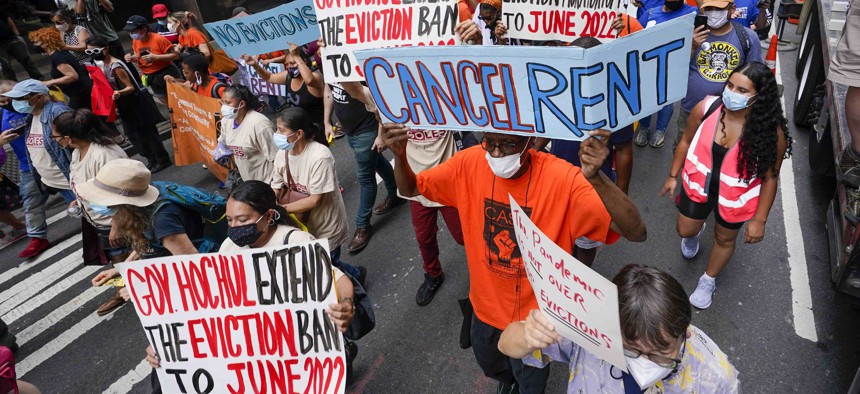How Many At-Risk Renters Live in States Without Eviction Protections?

Activist march across town towards New York Gov. Kathy Hochul office, Tuesday, Aug. 31, 2021, in New York, during a demonstration to call on Hochul, Speaker Carl Heastie, and Senate Majority Leader Andrea Stewart-Cousin to extend pandemic era eviction protections in wake of Supreme Court decision lifting the moratorium. AP Photo/Mary Altaffer
Researchers offer an estimate now that the Supreme Court has struck down a pandemic-era federal eviction ban.
There are about 2.1 million adult renters in the U.S. who believe they will be evicted in the weeks ahead and who also lack state or local protections to stave off that outcome, according to new research.
People in this group live in places without pandemic-era state or local eviction moratoriums that might fill the void left by a now defunct federal eviction ban that the U.S. Supreme Court struck down last week. The estimate of how many of these renters are out there is from a brief that researchers at the Urban Institute published this week.
"States and localities really need to issue these protections or there's going to be a lot of people who are at risk for eviction," Christopher Davis, a data scientist in the Metropolitan Housing and Communities Policy Center at the Urban Institute, and one of the co-authors of the report, said in an interview.
"Most renters across the country do not live in an area with an existing moratorium anymore," he added.
Davis pointed out that, after the Supreme Court ruling, some state and local governments are redoubling efforts to prevent evictions.
For instance, as part of a housing agenda, Boston Mayor Kim Janey is backing, the Boston Public Health Commission issued an order this week establishing a moratorium on evictions in the city, effective immediately. And in New York, state lawmakers were expected to extend an eviction ban during a special session on Wednesday.
A Census Bureau survey conducted Aug. 4 to Aug. 16 found that about 3.5 million renters think it is "very" or "somewhat" likely they will be evicted in the next two months. The Urban Institute researchers used this data in coming up with their estimates.
The brief also relies on information from the Covid-19 U.S. State Policy database that shows 13 states and Washington, D.C. have eviction moratoriums that shield at least some renters facing eviction. Additionally, eight localities in states without eviction restrictions offer protections to renters, the Urban researchers note.

Last week, the Supreme Court ruled that the U.S. Centers for Disease Control and Prevention overstepped its authority when in August it extended eviction protections through Oct. 3. Congressional approval is needed to enact such a policy, the court's majority said.
Earlier versions of the CDC ban have been in place since last September.
Property owners and their advocates, including realtor groups that challenged the CDC policy in court, have increasingly criticized the bans. They say that landlords are being forced into an untenable position as they try to pay their own bills without rent coming in.
Congress approved $46.5 billion in rental aid as part of pandemic relief legislation. States and localities are facing scrutiny for not getting that money out faster. Even with eviction bans in place, back rent will eventually come due for renters who have fallen behind.
There are other policies states and localities can pursue alongside or in lieu of eviction bans. Mediation programs for tenants and landlords and eviction diversion programs are two examples Davis mentioned. He added that bundling rental assistance with eviction diversion programs in the court system, could help with delivering the aid.
Davis also said that the figures presented in the research brief are likely underestimates, in part because some people who live in places with state or local eviction bans fail to meet eligibility criteria for the programs. A copy of the Urban brief is here.
Bill Lucia is a senior editor for Route Fifty and is based in Olympia, Washington.
NEXT STORY: The Prison Population is Falling, But in Some States Lots of People Are Still Locked Up






